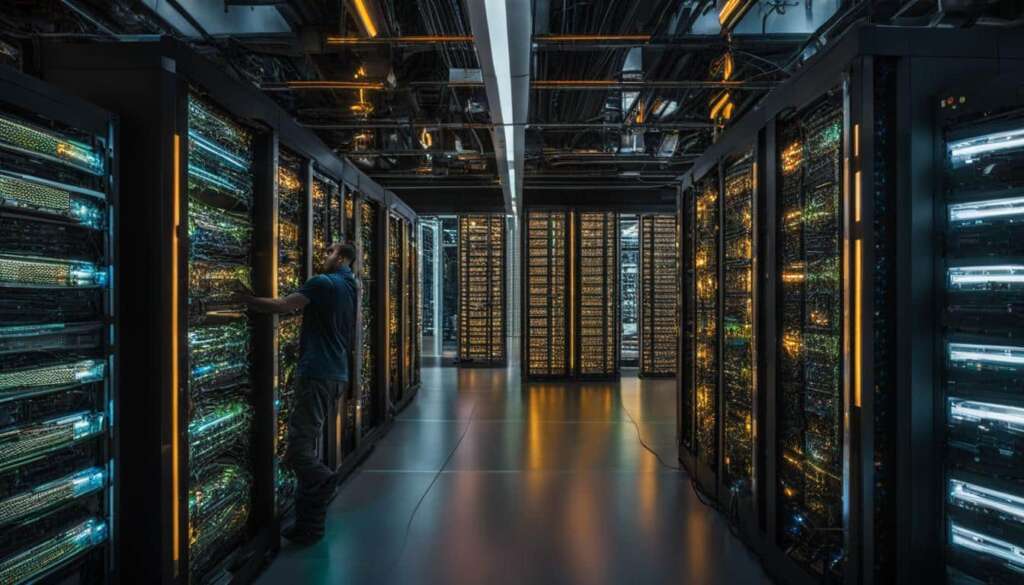Table of Contents
A computer server is a vital component in the digital world. It plays a crucial role in enabling various functions and services that we rely on every day. Whether you are browsing the web, sending an email, or accessing a database, a computer server is working behind the scenes to make it happen.
So, what exactly is a computer server? In simple terms, it is a program or device that provides services to other computer programs and users, known as clients. It can refer to a physical machine or a virtual representation, as well as software performing server services.
Servers operate on the client/server programming model, where server programs fulfill requests from client programs. They can be used for a wide range of purposes, including data storage and retrieval, hosting websites, managing applications, and much more.
To better understand the importance of computer servers and how they work, let’s dive deeper into their functionality and explore the various types of servers available in the digital landscape.
How Servers Work
Servers play a vital role in the digital world by facilitating communication and providing services to clients. Understanding how servers work is essential in grasping their significance and the client/server programming model they operate on.
The Client/Server Programming Model
At the core of server functionality lies the client/server programming model. In this model, a server program waits for requests from client programs and delivers services based on those requests. This dynamic allows applications to function as both clients and servers, depending on their interactions with other programs.
By using the client/server programming model, developers can create complex and interconnected applications that rely on servers to process and respond to client requests efficiently.
Server Program and Functionality
A server program is responsible for waiting for, processing, and fulfilling client requests. It operates in a continuous loop, actively listening for incoming requests and delivering the corresponding services.
A server program can take various forms, such as:
- A physical machine dedicated to running server software.
- A virtual representation of a physical server, hosted on a hypervisor.
- Software running on a computer, providing server services.
Regardless of the form it takes, a server program assumes the role of a dependable and reliable entity, consistently waiting for and serving client requests.
Visual Representation
To visualize the interaction between servers and clients in the client/server programming model, refer to the diagram below:
| Server | Client |
|---|---|
| Waits for requests | Sends requests |
| Responds to requests | Receives responses |
| Provides services | Accesses services |
Benefits of the Client/Server Programming Model
“The client/server programming model empowers developers to create distributed applications that leverage the processing power and services provided by servers. It enables applications to utilize network resources more effectively and scale to meet the demands of an evolving digital landscape.”
– Jane Smith, Software Engineer
The client/server programming model offers several advantages, including:
- Efficient utilization of server resources
- Scalability to handle increasing client demands
- Improved performance through distributed processing
- Enhanced security measures and access control
- Flexibility for applications to function as clients and servers
By harnessing the power of the client/server programming model, developers can build robust and interconnected applications that deliver efficient and reliable services to users.
Physical and Virtual Servers
In the world of computer servers, there are two main categories: physical servers and virtual servers. Understanding the differences between these two types is essential for effective server management.
Physical Servers
A physical server is a tangible computer system used to run server software. It consists of hardware components such as a processor, memory, storage, and network interfaces. Physical servers are commonly used in data centers and server rooms to host applications, store data, and provide services to clients.
Physical servers are known for their robustness and reliability. They can handle high workloads and offer excellent performance. However, they require dedicated physical space, power supply, cooling, and regular maintenance. Scaling up physical server infrastructure can be costly and time-consuming.
Virtual Servers
A virtual server, on the other hand, is a virtual representation of a physical server. It is created by partitioning the resources of a physical server using virtualization software, such as a hypervisor. A hypervisor allows multiple virtual machines, each running its own operating system and applications, to coexist on a single physical server.
Virtual servers offer several advantages over physical servers. They allow for greater resource utilization, as multiple virtual machines can share the same physical server. This reduces hardware costs and improves energy efficiency. Virtual servers are also highly scalable, making it easier to add or remove resources as needed.

Virtual servers are particularly valuable for businesses with fluctuating workloads or those that require a high level of flexibility in their IT infrastructure. By leveraging virtualization technologies, organizations can optimize resource allocation, enhance data center efficiency, and simplify server management.
Despite their many advantages, virtual servers come with their complexities. The management of virtual infrastructure and the performance of virtual machines depend on the efficiency of the underlying hypervisor technology. It requires careful configuration, monitoring, and maintenance to ensure optimal performance.
Ultimately, the choice between a physical server and a virtual server depends on the specific needs and requirements of an organization. While physical servers offer reliability and performance, virtual servers provide scalability and cost-effectiveness.
Next, let’s explore the different types of server software and operating systems that are commonly used in server environments.
Server Software and Operating Systems
A server relies on two vital software components: an operating system and an application. The operating system serves as a foundational platform for running the server application and managing hardware resources. This allows for efficient communication between clients and the server application.
“A server without proper software is like a ship without a captain.”
Server software encompasses a range of specific applications tailored to perform various tasks. These tasks may include web hosting, email management, database hosting, and more. Each application serves a distinct purpose and offers specialized functionalities to meet specific server requirements.
To illustrate the significance of server software and operating systems, let’s consider a common scenario: web hosting. In this case, the server software would be responsible for hosting and serving web pages, facilitating seamless website accessibility for users.
Examples of Server Software Applications:
- Web server software: Enables hosting and serving websites.
- Email server software: Handles email communication and management.
- Database server software: Provides a platform for hosting and managing databases.
- Application server software: Runs applications and provides their logic to clients.
These examples highlight the diversity and importance of server software in shaping the digital landscape.
| Server Software | Description |
|---|---|
| Web server software | Enables hosting and serving websites |
| Email server software | Handles email communication and management |
| Database server software | Provides a platform for hosting and managing databases |
| Application server software | Runs applications and provides their logic to clients |
The table above summarizes specific server software applications and their respective descriptions.
By employing the appropriate server software and operating systems, organizations can optimize their server infrastructure and deliver enhanced services to clients and users.
Differences Between Desktop Computers and Servers
When considering the comparison between desktop computers and servers, it’s important to note both their similarities and differences. While these two types of machines share certain fundamental characteristics, they are designed with distinct purposes in mind. Let’s explore the key distinctions in terms of hardware and operating systems:
Hardware Considerations
Most servers utilize X86/X64 CPUs, which means they have the capability to run the same code as desktop computers. However, servers often possess more advanced specifications to handle demanding workloads. Here are some notable differences:
- Servers typically have multiple CPU sockets, allowing for increased processing power and improved performance. Desktop computers usually have a single CPU socket.
- Server hardware often features error correcting memory (ECC), which is designed to detect and correct data corruption. This ensures the reliability of data stored on servers. Desktop computers generally do not have ECC memory.
- Servers are equipped with a higher memory capacity compared to desktop computers. This is crucial for handling large-scale applications, databases, and virtualization environments.
- Server hardware is designed to prioritize high availability and redundancy, minimizing the risk of downtime. Redundant components such as power supplies, hard drives, and network interfaces are common in server configurations.
By contrast, desktop computers prioritize individual productivity and lower cost, hence their hardware specifications are typically geared towards personal computing needs rather than extensive server operations.
Distinct Operating Systems
Another key difference lies in the choice of operating systems. While desktop computers predominantly use consumer-oriented operating systems such as Windows, macOS, and Linux distributions, server environments often rely on specialized server operating systems. These server operating systems are optimized for managing network communication, security, and resource allocation. Some popular server operating systems include:
- Windows Server
- Linux distributions such as CentOS, Ubuntu Server, and Red Hat Enterprise Linux
- UNIX-based operating systems like FreeBSD
These server-specific operating systems offer robust features that prioritize stability, security, and scalability, catering to the unique demands of server use cases and facilitating efficient server management.
Overall, while desktop computers and servers share similarities in terms of CPU architecture and code compatibility, their hardware specifications and choice of operating systems diverge significantly. Servers are purpose-built machines with high-performance capabilities, ensuring maximum reliability and scalability in demanding server environments.
| Specification | Desktop Computers | Servers |
|---|---|---|
| CPU | Single CPU socket | Multiple CPU sockets |
| Memory | Lower capacity | Higher capacity |
| ECC Memory | Not common | Common |
| Redundant Components | Less common | Common |
| Operating System | Consumer-oriented (Windows, macOS, Linux) | Specialized server operating systems (Windows Server, Linux distributions, UNIX-based) |
Types of Servers
Servers can be categorized based on their purpose and function. Understanding the different types of servers is essential for optimizing their usage in various digital environments.
Web Servers
A web server is the foundation of websites and online applications, handling requests from clients and delivering web pages. It processes HTTP or HTTPS protocols and responds to requests with the necessary HTML, CSS, and other data to render web pages. Common web servers include Apache HTTP Server, NGINX, and Microsoft IIS.
File Servers
File servers store and manage files, serving as central repositories accessible by users and devices within a network. They facilitate file sharing, collaboration, and centralized data management. File transfer protocols such as FTP, SMB, and NFS are commonly used for file server communication.
Mail Servers
Mail servers handle email communication, enabling the sending, receiving, and storage of messages across networks or the internet. These servers utilize protocols like SMTP (Simple Mail Transfer Protocol) and IMAP (Internet Message Access Protocol) to facilitate email delivery and retrieval.
Application Servers
Application servers run and manage specific software applications, providing functionality and logic to clients. They are designed to handle the processing, execution, and delivery of complex applications. Common application servers include Apache Tomcat, JBoss, and Microsoft .NET.
Other Types of Servers
In addition to the aforementioned types, there are several other specialized servers. These include:
- Proxy Servers: Intermediaries that handle client requests and forward them to the appropriate servers.
- Database Servers: Dedicated servers for managing databases, processing queries, and storing data.
- Print Servers: Servers that manage printing tasks and handle print job distribution.
Each type of server serves a specific purpose within the digital ecosystem, contributing to the seamless functioning of networks, applications, and data storage.
| Type of Server | Purpose | Common Examples |
|---|---|---|
| Web Servers | Serve web pages and process client requests. | Apache HTTP Server, NGINX, Microsoft IIS |
| File Servers | Store and manage files for network access. | FTP, SMB, NFS servers |
| Mail Servers | Handle email communication. | SMTP, IMAP servers |
| Application Servers | Run applications and provide logic to clients. | Apache Tomcat, JBoss, Microsoft .NET |
| Proxy Servers | Intermediaries that handle client requests. | Squid, HAProxy |
| Database Servers | Manage databases and process queries. | MySQL, Oracle Database, Microsoft SQL Server |
| Print Servers | Manage printing tasks and job distribution. | CUPS, Windows Print Server |
Server Components
Servers consist of various hardware components that work together to provide reliable and efficient performance. These components include:
- Rack mount chassis: Servers are typically housed in rack mount chassis, which allow for easy installation and organization in server racks.
- Power supply: A server requires a robust power supply to ensure the constant and uninterrupted delivery of power to all its components.
- System board: Also known as the motherboard, the system board connects and facilitates communication between all other hardware components in the server.
- CPUs: Central Processing Units, or CPUs, are the brains of the server. They handle all the computations and processing required to run the server applications.
- Memory: Servers typically have a larger memory capacity compared to regular computers, allowing them to handle multiple and resource-intensive tasks simultaneously.
- Storage: Server storage includes various options such as hard disk drives (HDDs) and solid-state drives (SSDs) to store data and applications.
- Network interfaces: These interfaces enable the server to connect to the network, allowing it to communicate and transfer data to other devices.
Additionally, most servers are equipped with out-of-band management capabilities, which enable remote management and monitoring. This allows system administrators to access and control servers even if the operating system is not responsive.
The server’s operating system is a critical component that provides a platform for running server applications and managing hardware resources. It acts as an intermediary between the hardware and the applications, ensuring smooth and efficient operations.
For virtual servers, a hypervisor is required. A hypervisor is responsible for creating and managing virtual machines, allowing multiple virtual servers to run on a single physical server. This virtualization technology enables greater resource utilization and flexibility in server deployment.
Overall, the combination of robust server hardware, a reliable operating system, and a capable hypervisor empowers servers to deliver the performance, scalability, and functionality required in today’s digital landscape.
The Role of Each Component
“The hardware components in a server work together to ensure efficient data processing and delivery. From the powerful CPUs that handle the computations to the high-capacity memory and storage for storing and retrieving data, each component plays a vital role in the server’s performance and reliability.”
The Significance of Servers in the Digital Age
Servers play a crucial role in the digital age, powering global connectivity, data storage and retrieval, collaboration, communication, business operations, security, scalability, and research and innovation. They enable websites and applications to function, securely store and access data, facilitate real-time interactions, and support businesses’ day-to-day operations. Without servers, the digital landscape as we know it would not exist.
One of the key contributions of servers is their significance in establishing global connectivity. Through servers, individuals and organizations can connect with one another across vast distances, enabling seamless communication, collaboration, and the sharing of information. Servers act as intermediaries that facilitate the exchange of data and ensure that it reaches its intended recipient, regardless of their location in the world.
Data storage is another essential aspect of servers. They provide the infrastructure to store vast amounts of information securely. Whether it’s personal documents, business records, or research findings, servers offer a robust and reliable solution for storing and retrieving data. This enables individuals and organizations to access their information anytime, anywhere, promoting productivity and efficiency in the digital era.
Servers also play a vital role in research and innovation. Scientists, engineers, and scholars rely on servers to process complex calculations, run simulations, and store massive datasets. High-performance servers enable researchers to conduct advanced computational analysis and accelerate the pace of scientific breakthroughs. Furthermore, servers provide a platform for collaborative research, facilitating information sharing and fostering global cooperation.
FAQ
What is a computer server?
A computer server is a program or device that provides services to other computer programs and users, known as clients. It can refer to a physical machine or virtual representation, as well as software performing server services.
How do servers work?
Servers work on the client/server programming model, where server programs fulfill requests from client programs. They wait for and fulfill requests from client programs, providing the services requested by clients.
What are physical and virtual servers?
A physical server is a computer used to run server software, while a virtual server is a virtual representation of a physical server. Virtual servers are created by installing a hypervisor, which allows a physical server to function as a virtualization host.
What software components are required for a server?
A server requires two main software components: an operating system and an application. The operating system provides a platform for running the server application and manages hardware resources.
What are the differences between desktop computers and servers?
Desktop computers and servers are similar in terms of running the same code and using X86/X64 CPUs. However, servers often have multiple CPU sockets, error-correcting memory, and support more memory than desktops. They also typically use a different operating system.
What are the different types of servers?
There are various types of servers, including web servers that serve web pages, file servers that store and manage files for network access, mail servers that handle email communication, and application servers that run applications and provide their logic to clients. Other types include proxy servers, database servers, and print servers, among others.
What are the components of a server?
Servers are composed of hardware components such as rack mount chassis, power supply, system board, CPUs, memory, storage, and network interfaces. Most servers also have out-of-band management capabilities for remote management and monitoring.
Why are servers significant in the digital age?
Servers play a crucial role in powering global connectivity, data storage and retrieval, collaboration, communication, business operations, security, scalability, and research and innovation. They enable websites and applications to function, securely store and access data, and support businesses’ day-to-day operations.












